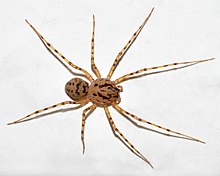Scytodidae
| Spitting spiders | |
|---|---|
 |
|
| Scytodes thoracica | |
| Scientific classification | |
| Kingdom: | Animalia |
| Phylum: | Arthropoda |
| Subphylum: | Chelicerata |
| Class: | Arachnida |
| Order: | Araneae |
| Infraorder: | Araneomorphae |
| Family: |
Scytodidae Blackwall, 1864 |
| Genera | |
|
See text. |
|
| Diversity | |
| 5 genera, 232 species | |
 |
|
See text.
Spitting spiders are members of the spider family Scytodidae. There are several genera, of which Scytodes is the best-known. Over 150 species of scytodids have been described worldwide.
Scytodidae catch their prey by spitting a fluid that congeals on contact into a venomous and sticky mass. Remarkably, though it is produced in venom glands in the chelicerae, the fluid contains both venom and spider silk in liquid form. The venom-impregnated silk both immobilizes and envenoms prey such as silverfish. In high-speed footage the spiders can be observed swaying from side to side as they "spit", catching the prey in a crisscrossed "Z" pattern; it is criss-crossed because each of the chelicerae emits half of the pattern. The spider usually strikes from a distance of 10–20 mm and the whole attack sequence is over in a little under 1/700th of a second. After making the capture, the spider typically bites the prey with venomous effect, and wraps it in the normal spider fashion with silk from the spinnerets.
Like the Sicariidae and Diguetidae these spiders are haplogyne (having less complex female genitalia), and have six eyes arranged in three pairs. The Scytodidae differ from the Sicariidae and Diguetidae in having a dome-shaped carapace and in their characteristic flecked pattern of spots.
Some species exhibit presocial behaviour, in which mature spiders live together and assist the young with food.
As of November 2015[update], the World Spider Catalog accepted the following genera:
...
Wikipedia
